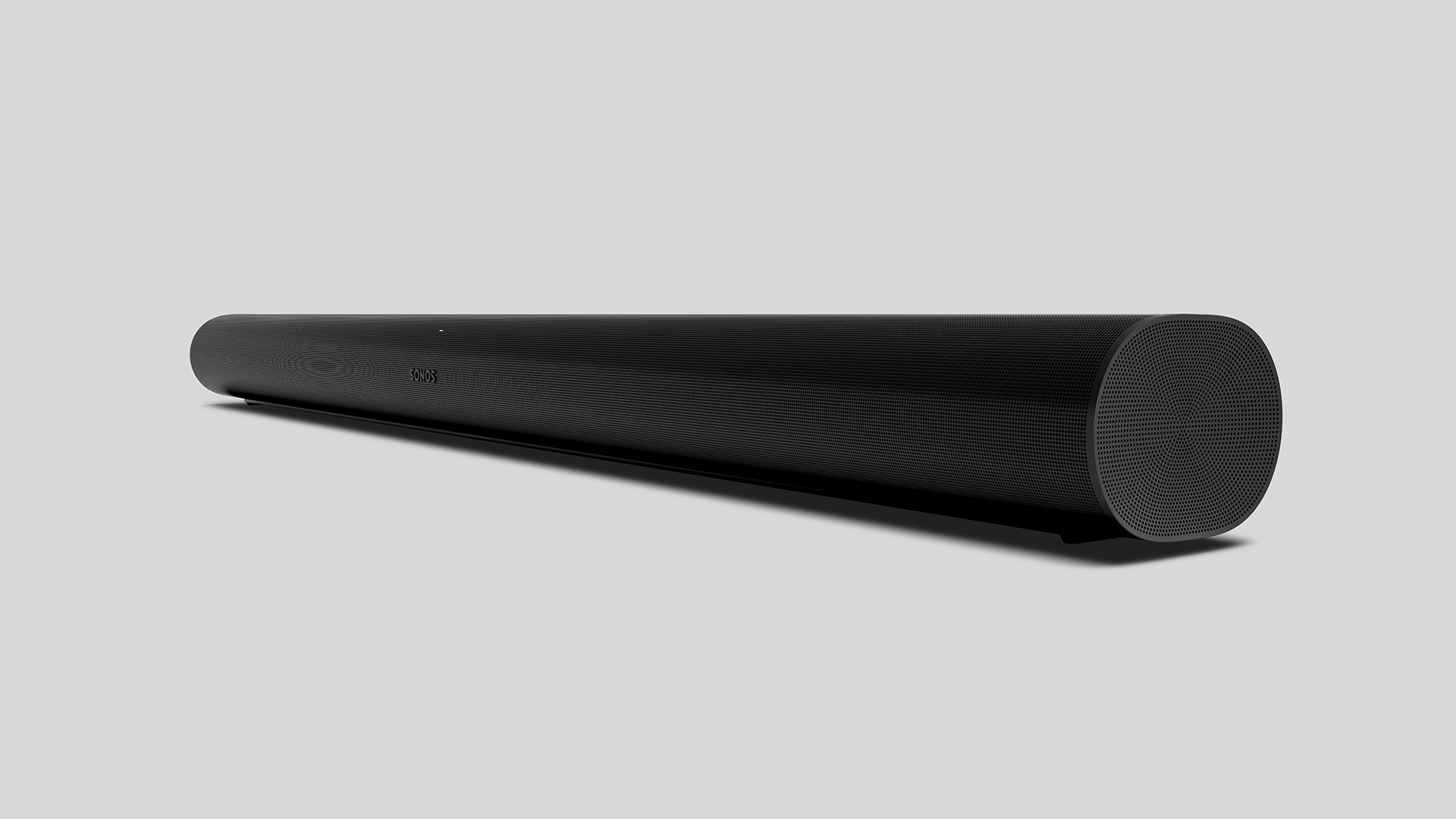
Our man Jonathan Evans has now been living with the Sonos Arc for over two years. If you've already read parts one and two, you can skip ahead to his latest update.
I must confess to getting a little bit overexcited when I heard about the Sonos Arc, a Dolby Atmos enabled soundbar at a price that, while by no means cheap, is still considerably more affordable than other similarly enabled products of decent competence.
After moving house 18 months or so ago, I’d been biding my time as far as a home AV set-up goes. The fully loaded 7.1 Onkyo-powered surround system of my old house is no more – I simply don’t have the space in my new living room to house all those speakers; so I’d been thinking about a soundbar as a replacement.
Clearly I won’t ever get the precision or power of a full system with a soundbar, that much I realised, but practicalities simply have to override such things for me – and a good approximation of surround sound may well be enough to do the trick. The household has been subjected to the sound coming from my 55-inch Samsung TV for a year and a half now – and to be fair the kids haven’t been complaining too much. But what do they know?
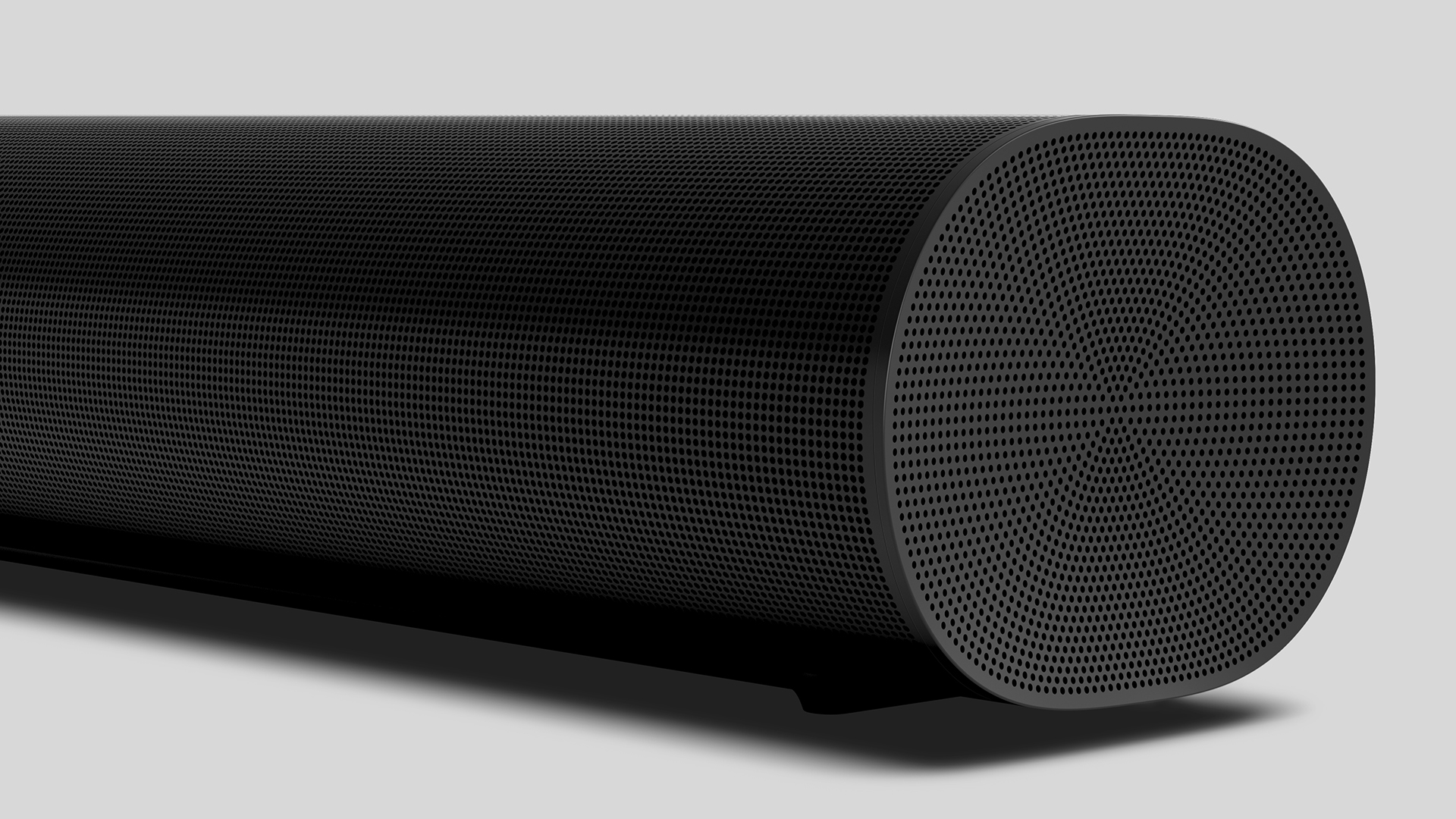
While the Sennheiser Ambeo - a veritable beast of a soundbar - would in many ways be perfect, there’s no way I can justify spending two grand on one; so I’ve been biding my time impatiently for a more affordable alternative to come along.
I almost took the plunge with the Sonos Beam (and, as events later reveal, perhaps I may yet do so…), but didn’t really pull my finger out in time to get it sorted before the Arc was announced.
So, sitting at the dining room table that has served as my work desk for most of the period of lockdown, I waited for the team to complete its review, with fingers crossed.
One five-star verdict later, and someone (ahem…) suggested that it might be a great idea for us to really put it through its paces in a real world, long-term test.
Hopes and lofty ambitions
Having read the review and talked to the reviewers, I knew that there were likely to be issues with my set up at home. But you know how it is with these things: once you get an idea in your head, you just want to plough on regardless and hope that it all turns out okay in the end.
And, to be fair to the Sonos Arc, for the most part it really has.
First things first, though. This is a very impressive looking piece of kit. It’s certainly premium in feel and build. It comes nestled in a reassuringly solid box, with heavy-duty locking tags that make the whole thing seem even more upmarket. The unit itself is everything you would expect of a Sonos product - and, despite its undeniably beefy dimensions, looks quite at home and rather neat sitting under my television.
Set up was a fairly simple affair - which was a mighty relief to me, as I had made a half-hearted effort to use a Sonos Amp as my TV’s sound source last year, and that caused me a fair bit of trouble (due, I found out in the end, to an issue with the HDMI cables I was using). So it was with some trepidation that I plugged the Arc in to the Samsung’s One Connect box, using the HDMI cable supplied with the soundbar.
A positive handshake
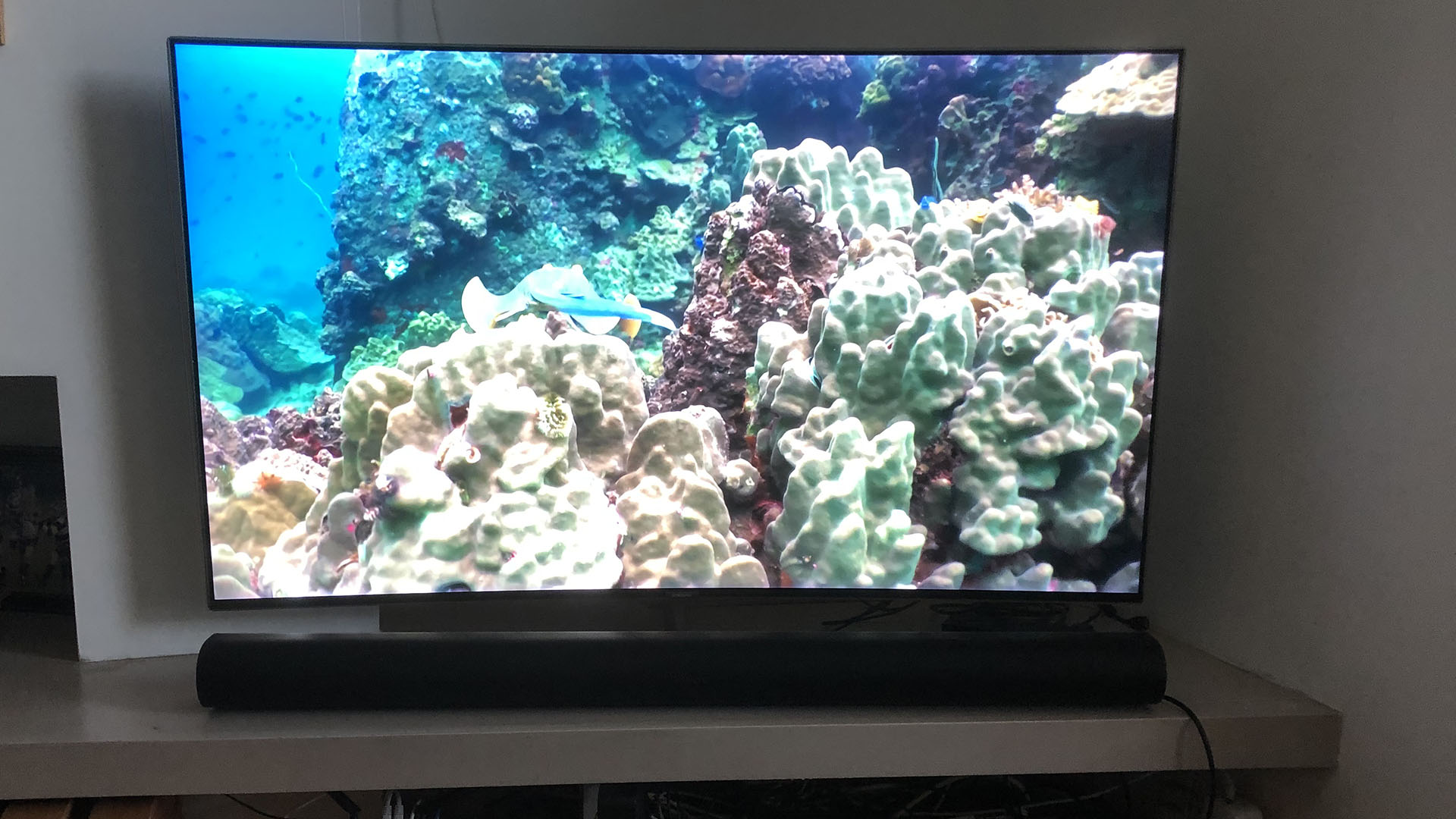
I need not have worried. The Samsung UE55KS9000 immediately shook hands with the Arc via the supplied HDMI plugged into its ARC (audio return channel), and all felt more reassuring with the world.
Then it was simply a case of downloading the Sonos app onto my iPhone and letting the pair do their set-up thing. (The Arc works only with the new S2 version of the Sonos app, so you’ll need to download that if you’ve got legacy Sonos kit and are still on 1.0).
The phone app found the Arc quickly, and then set me on the way to setting things up. It’s an interesting process, involving, among other things, moving around the room wafting your phone about while the soundbar beeps at you, gauging the dimensions and sonic characteristics of the space it has to work in.
That reasonably fast set up process gone through, we were good to go.
It’s safe to say that the Arc was instantly impressive. Not a massively surprising statement perhaps, given that it was competing with the TV’s speakers; still, instant gratification nevertheless. Voices are precisely placed, and extremely clear, the spread of sound is in a completely different league, and there is texture and depth to the bass. It’s night and day.
What it’s not, of course, and nor could it ever really be, is a proper AV amplifier driving seven speakers - but as I’ve already explained, I have now written that off as an option, so I’m not in any way disappointed.
One of the issues I have had with the Samsung is that the volume would vary with the input - so the Sky Q box, for example, would be playing at a comfortable level, but then if the PS4 was booted up, it was always much louder, and the remote control had to be scrabbled for.
The Arc has removed this irritation for the most part. The sound from the Samsung is fed to the Sonos via the the TV's ARC-enabled HDMI output, and it all comes out of the soundbar at the same volume. This may seem a rather minor irritation but it became less and less minor as time wore on - and I’m extremely happy to be rid of it.
And the volume is controlled by the Sky Q handset, now I’ve told it to be, so the Arc sits there waiting to be of service without fuss. Turn the TV on and the Arc comes on with it. It’s all very neat and intuitive.
Won't somebody please think of the children?
I’d set all this up in an empty house, so I was interested to note the reaction of the rest of the household, and said nothing about the change in sonic setup. The kids (who, as is the way with teenagers, are astonishingly unobservant about such things in general) barreled into the living room, turned on the telly and started watching Netflix (Ru Paul’s Drag Race, I believe.)
Within 20 seconds or so, I was asked, “What’s happened to the sound?” It was only after that that the question came, “and what’s that in front of the telly?” (see comment about observation skills above).
So first impressions very good all round - even for the unobservant teenagers.
Coming down off the high
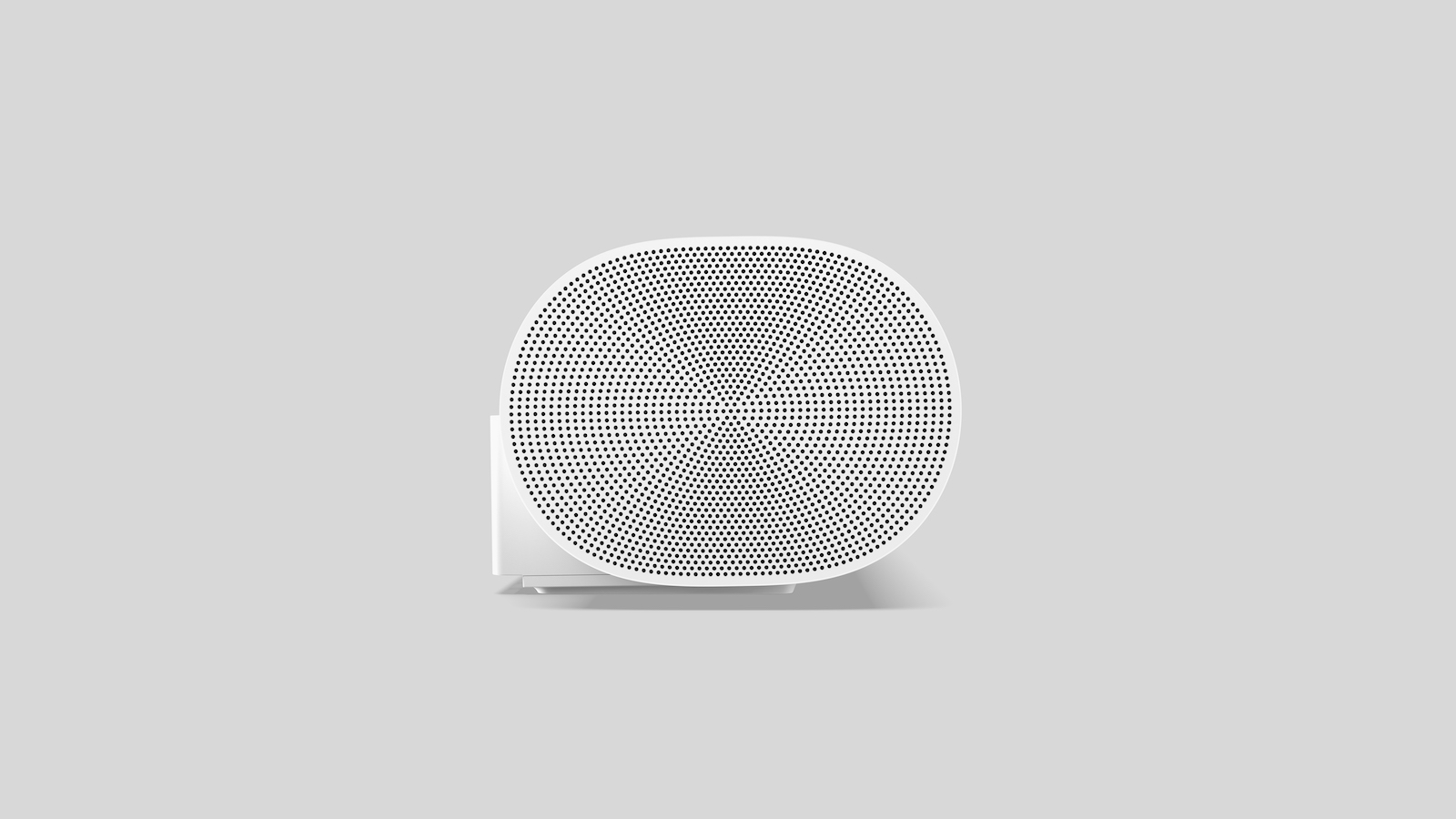
It was when I started looking into fine-tuning things and trying to test out the surround-sound capabilities that a little bit of the gloss started to come off. I hasten to add, the main issue really isn’t the Arc’s fault. And as I’ve said, this wasn’t an enormous surprise by any means, but it was still just a tiny bit devastating.
My TV won’t pass through a Dolby Atmos signal.
It’s a great TV, the UE55KS9000 (and many people have commented on its impressive picture over the past three and a half years), but it’s been left behind by Samsung on the update front. The first time this frustrated me was when the BBC started broadcasting 4K content over iPlayer. The set doesn’t support HLG, so couldn’t show any of the events (Wimbledon, the 2018 World Cup) that the Beeb put out.
And this (the fact that it won’t pass through a Dolby Atmos signal) is the second crushing disappointment it has meted out.
The best I can manage, having tinkered with the TV’s settings is 5.1 surround - the app will tell you what the soundbar is outputting.
Still a very impressive sound in 'plain' 5.1
Thankfully, the plain vanilla 5.1 sound is pretty impressive in its own right; it certainly makes a good fist at spreading the soundtrack of an action movie out wide, and giving very decent sound location. But it’s not Dolby Atmos. There’s no way around this, other than getting hold of a new TV of course, and, while I am positively itching to experience the full fat sonic abilities of the Arc, I really can’t justify replacing what is a pretty fine TV still.
It may just be, though, that the Arc is therefore overkill for me. A Sonos Beam may well do close to the same job for half the cost. Something, for sure, for the prospective Arc purchaser to investigate.
Despite my frustrations, I am still deeply impressed by the Sonos Arc - and I have a few ideas to come to see how I might improve things further; chief among these involves a visit to IKEA and the purchase of two Symfonisk bookshelf speakers to act as true surround speakers for the system.
For that, watch this space: I shall update this particular story Arc in due course, once my family and I have lived with the new Sonos soundbar for a while longer.
Update 1: Dolby Atmos at last!
Update: Dolby Atmos at last!
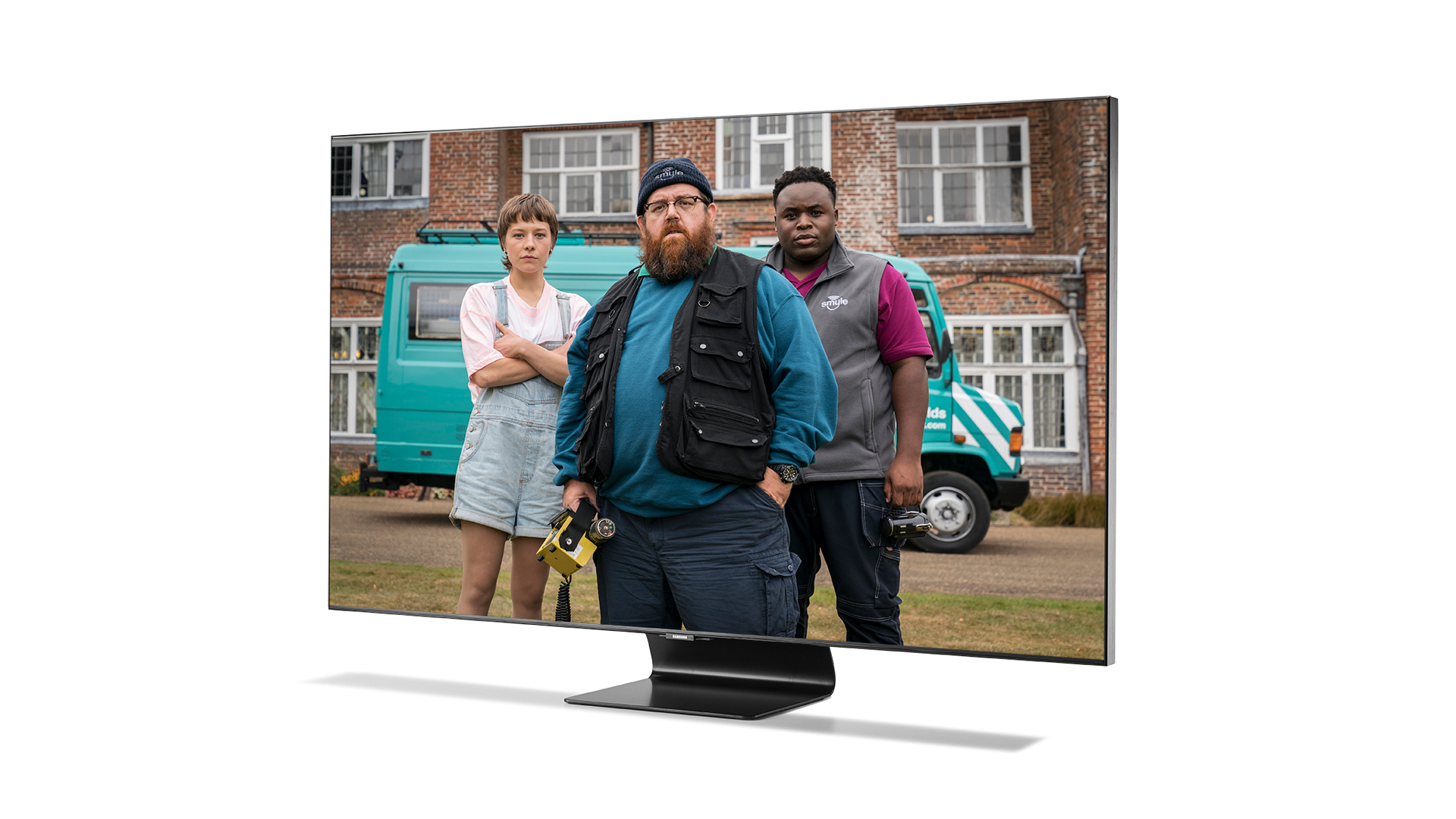
Well, I couldn’t resist. I had to find out how the Arc performs with a Dolby Atmos signal, and I happened to find myself in our Bath AV test room a while ago. There was a relatively new model 55in Samsung TV (the excellent QE55Q90T) sitting there patiently, just begging me to borrow it for a while. It was but the work of a moment to comply with its wishes and stick it in the back of the car. (I know: it's all right for some. But at least now I can get an idea of how Atmos sounds from the soundbar.)
Once I got it home and set things up, I dived straight in to The Witcher on Netflix (for some reason it’s pretty much the only show that I am able to recall reliably as having Dolby Atmos sound).
The difference between listening to the Dolby Atmos soundtrack compared with the (very good, still) 5.1 surround sound I had been hearing before was clear. Dolby Atmos adds a lot of space to the soundstage, opening things up impressively. The soundstage is immediately wider and effects are quite effectively placed and moved around the room.
Indeed, over the past few weeks I have, on a number of occasions, started to wonder what was happening in another room of the house, only to then realise that the sound I was hearing was coming from the soundbar, reflected off the side walls of the room, rather than straight from the hall or kitchen.
Now I’m certainly not saying that the improvement in sound and atmosphere is necessarily worth splashing out on a new TV for if your current set won’t pass through Dolby Atmos; but if you’re in the market for a new set, it’s something I would definitely take into account.
It’s also, in my set-up's current configuration, nowhere near as effective a surround sound solution as a full seven-speaker set-up. For the Arc to have a chance of approaching that, I will need to get a couple of other Sonos speakers to act as proper surrounds. But as a compromise solution, in a room that simply cannot house all the extra boxes required for a full set-up, this is a rather fine alternative.
A worrying glitch
Things haven’t been plain sailing for the Arc, however, despite my excitement at hearing the impressive Atmos performance. After a week of using the new TV with the soundbar without issue, the system developed what could have been a serious problem.
Every five or six seconds, the sound would drop out for half a second or so. It was a persistent occurrence and made watching anything pretty much impossible. It was a puzzle, especially as all had been fine with the new TV for the first week of using it.
I unplugged and reinserted the HDMI cable, to no effect. I swapped the cable out for another one; also to no effect. A quick Google (not sure why I didn't just try that first) showed that this is a known issue with the Arc with some televisions. The solution, I read, was to do a full reboot of the Arc (rather than simply unplug and reconnect the HDMI cable).
The thread was undeniably worrying, in that a number of people have said that it is a frequent problem for them. All I can say is that, after the reboot, I haven’t experienced a recurrence of the issue over the course of three or four weeks. So fingers well and truly crossed there.
Next steps
The next steps then, as already mentioned above, are to get a couple of smaller speakers to act as surrounds in the set-up, so I can get as close to a full-blown surround sound system as possible. I have rather high hopes for that, if the improvement from 5.1 to Dolby Atmos is any hint as to the improvement possible.
I had intended to use a couple of the IKEA Symfonisk speakers, as they act as a shelf as well; I have nowhere to put two Sonos Ones, and it feels like a neater - and cheaper, of course – solution. I shall take advice on that though; it's possible that I may go for the Ones – but then I shall need to rely on my DIY skills as far as finding them a place to sit.
Watch this space…
Update 2: a glitch, extra height and proper surrounds
Update: another glitch, extra height and proper surrounds
Plenty has been going on over the months since my last living-with-the-Arc update.
I have changed TVs once again; there has been an update to the soundbar’s software, so the height drivers’ volume can now be adjusted separately from the rest; and I have installed a pair of rear surround speakers.
Each of these adjustments has changed things to a greater or lesser extent – but almost entirely for the better.
There have also been some gremlins along the way, however – chief among them, an irritating lip-synch issue with my Sky Q box.
Lip-synch shenanigans
Let’s start with the irritations. No matter which television I have been using, there has been a seemingly permanent issue with lip-synching live programming from the Sky Q box, when it is in its multichannel out audio setting. There are often issues like this with AV amplifiers, of course, and it is usually a fairly simple issue to resolve, with most pieces of AV kit able to delay the audio output to put it in perfect timing with the mouth movements of whoever happens to be speaking on screen.
Those tweaking abilities, however, are useless in this case, as it is the sound that is coming after the image - so delaying it makes the situation only worse. Programming in standard definition doesn’t have the issue, so it seems to be something to do with HD and 4K programming coming from the Sky box.
It honestly makes watching most programmes so annoying as not to be worth it, and it’s more than a minor delay - it’s incredibly obvious to everyone. Watching Huw Edwards mouthing the news before he says it is disconcerting to say the least. Sky hasn't yet come up with an answer to this for me, but a quick internet search certainly shows that I’m not the only person to suffer this issue.
It isn’t such a problem for streaming services via the Sky Q box, but I have been going to my TV’s apps for the likes of Netflix, Amazon Prime and so on – simply because I haven’t really trusted the Sky Q box. In the end, as a compromise, I have set the Sky Q to output just stereo sound for most of my general live TV watching (which removes the lip-synch problem), and then switch settings manually when I want to watch, say, the 4K, Dolby Atmos football broadcasts on Sky Sports.
It’s not an ideal solution, of course, but it takes only about 12 seconds to sort out, so it’s also not the end of the world.
New TV number two…
On a more positive note, I haven’t had any further recurrences of the issue I had when the sound dropped out regularly on my original Samsung TV. The second Samsung set didn’t have the issue, and I have now moved on again, this time to a Philips 65OLED804.
This switch was made partly because I wanted to make sure the Arc would play Atmos via HDMI ARC (audio return channel) as well as the newer Samsung’s more high-tech eARC – the original Samsung set I had didn’t relay Atmos over its old-school (2016…) HDMIs.
The other reason I was keen to try out the Philips, I confess, is that I haven’t yet enjoyed an OLED TV at home – nor, come to that, the delights of Ambilight. On which note, it must be said that the teenage occupants of my house are immensely impressed with Ambilight (more than they were with the switch from the excellent Samsung QLED to OLED, if I’m honest, although they are particularly happy with the Philips’ picture as well).
Suffice to say that the Philips set copes admirably with Dolby Atmos signals via its HDMI ARC ports, and the system seems to be working well, for the most part.
I have had a few occasions when the Philips TV seems to have the occasional handshake issue with the soundbar, which necessitates a bit of a reboot. But that seems to have been resolved with a change of HDMI cable.
Tweaking the height channels
The recent Sonos software update has brought in an interesting new toy. I can play with the volume of the height channels to bring them into greater prominence (or pretty much remove them from the equation, should I wish).
Go into the new option on the Sonos app, and you are presented with a slider, with a scale going from -10 through 0 to 10. It is set, by default at 0. I had a play with this using my default Witcher scenes, and the difference between a -10 setting and the full-on all-guns-blazing 10 is clear, as one would hope.
It’s worth having a play with the feature, certainly; my living room has a fairly high ceiling, and adding more oomph to the heights has brought a more rounded image to the sound even from the 0 setting. I’ve settled on around 7, but I’m still enjoying tinkering with things.
Rear surrounds are in
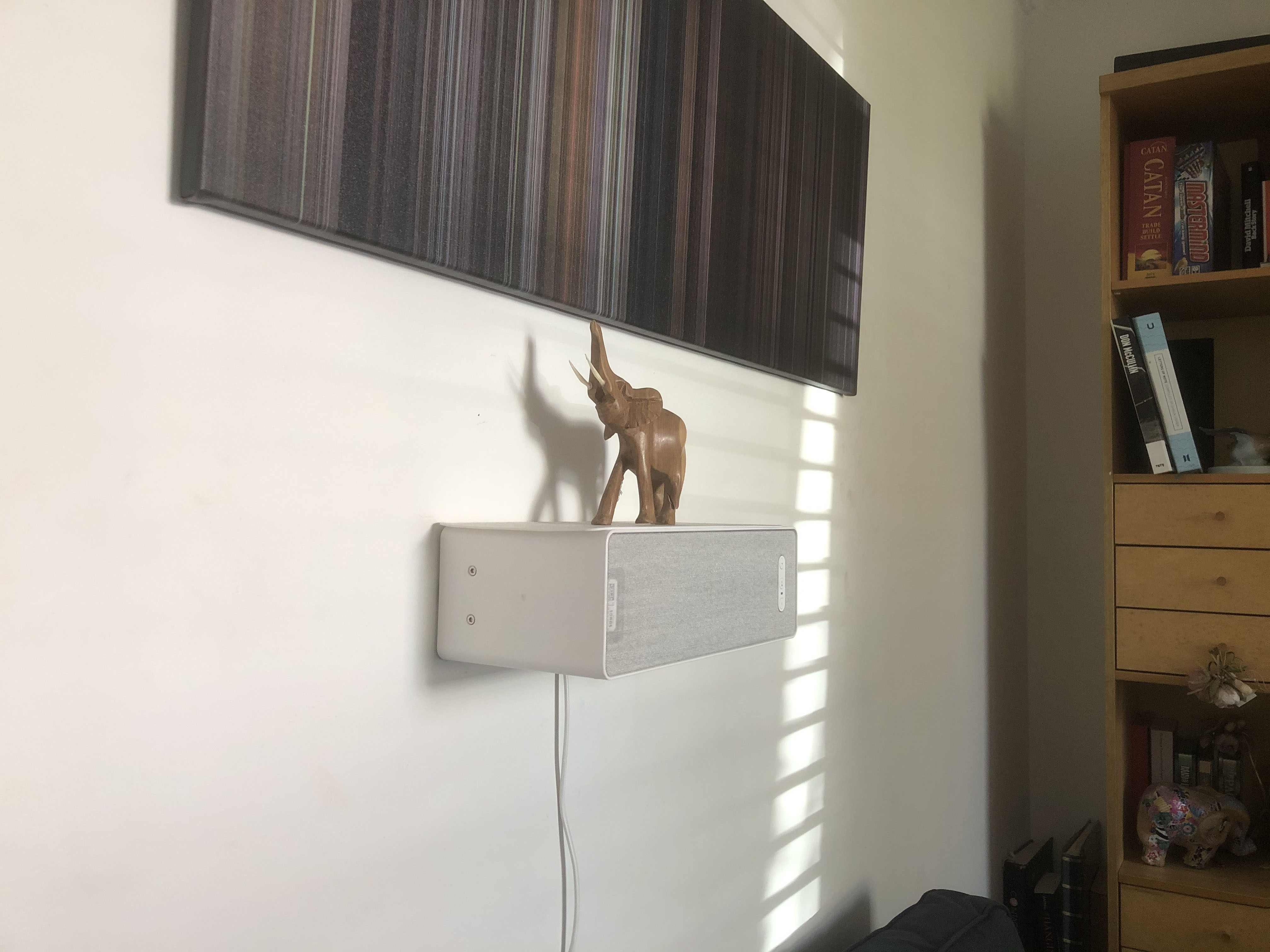
Also new on the scene is a pair of IKEA Symfonisk bookshelf speakers to act as rears in a more conventional surround sound system.
I went for the Symfonisks in the end as it seemed the simplest option – they act as shelves in their own right, so cut down a little on the DIY. Also, as I am using this pair exclusively as surround speakers, I didn’t feel that I needed them to be the very best sounding option out there, merely that they should be able to perform their duties to a high standard. And besides, being entirely practical about things, they also come with a roughly 50 per cent saving over the nearest Sonos branded option, the One SL.
(A new Sonos/IKEA collaboration seems to be imminent, so it’s possible some discounts may be in the offing on the Symfonisk family.)
Setting the Symfonisk pair up after screwing them to the wall was a pleasingly simple exercise, once I'd updated their software (for which I needed to hard-wire them to the router), with the app on my iPhone finding the new units quickly, and then allowing me to make a system from the three speakers with the push of a couple of buttons.
While I have been impressed with the soundbar’s ability to provide a very decent attempt at true surround sound on its own, it was immediately clear that having discrete speakers at the rear, leaving the bar to perform front centre, left and right duties (along with the Atmos height, of course) improves things remarkably. This is now a ‘proper’ surround system, with the sonic soundstage far more accurately described by the trio of speakers.
I'm very happy with the results for the relatively modest outlay of less than £200. That does, of course, take the system cost up to £1000, but I feel this Sonos combination isn't out of place at that price – especially given the space it frees up over a conventional home cinema sound system.
And, of course, it is an upgrade that can be made in time as and when it can be afforded. The soundbar was impressive enough in its own right. The bespoke rears do raise it to another level, though.
Update 3: new wi-fi creates problems
When should you just leave things well alone?
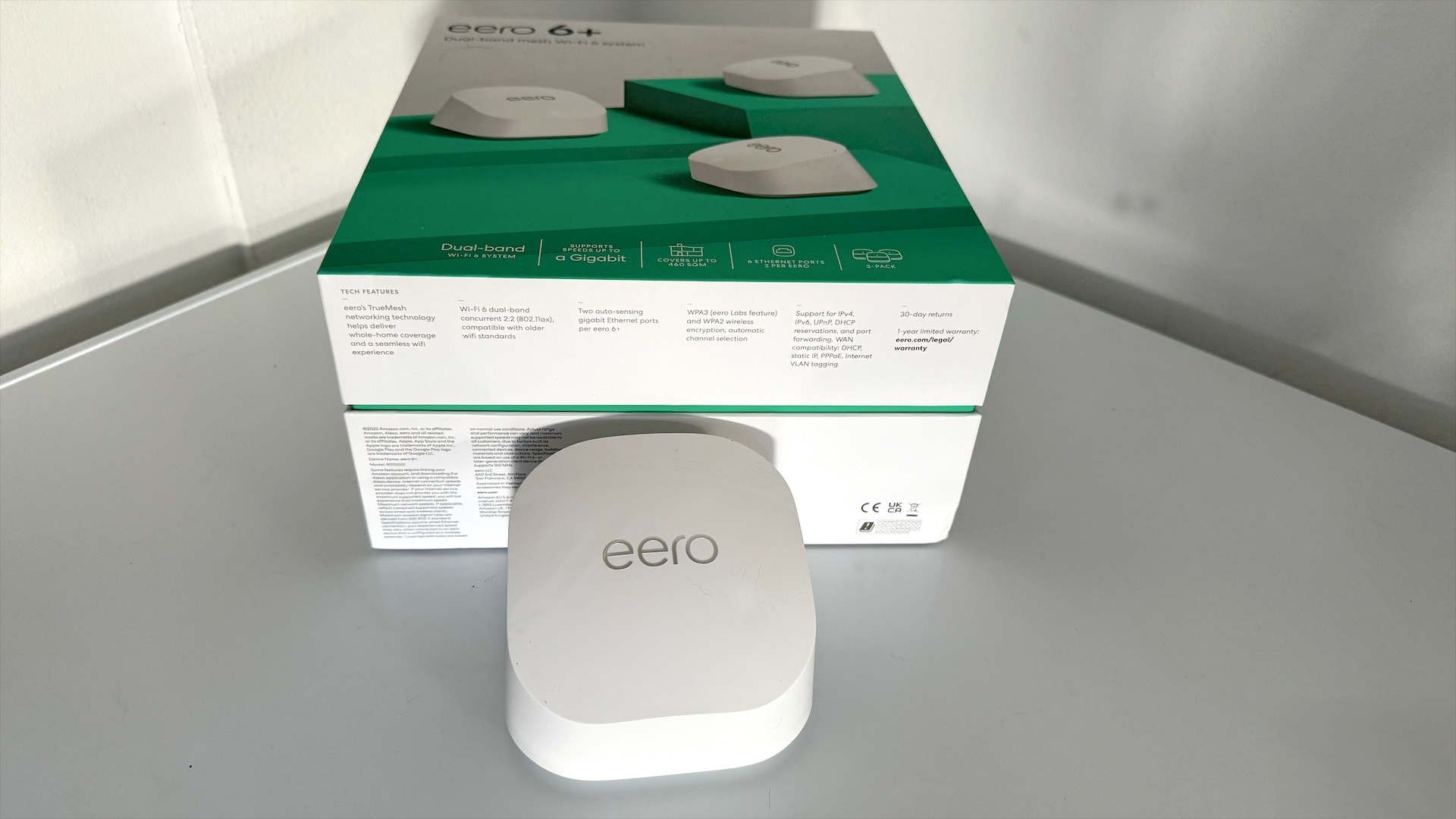
I had been living very happily with my Sonos AV set-up – Arc and two IKEA Symfonisk shelf speakers taking up rear-surround duties – for the past couple of years and more.
But then I had a tinker… I have been in this game for long enough that I really ought to have known to leave well alone. But no: I had to try to “improve” things.
To be fair, it wasn’t with the Sonos set-up that I felt the urge to play; but, having made the changes, it became immediately clear that the impact on my sound system was pretty cataclysmic.
You see, the wifi in my house had always been pretty patchy; I have, over the years, tried to sort things out with a powerline system that sends data through the mains, which was just okay enough to mean that I then didn’t try to improve things any further.
I got tipped over the edge by the poor reception in my kitchen, which meant that my Sonos One kept falling off the grid somehow. So no cooking tunes. Which, in my book, is unacceptable.
So I did some research into boosting my Virgin Media broadband signal with a mesh system. I plumped for the Amazon eero 6+, as a good mid-priced option that was well reviewed.
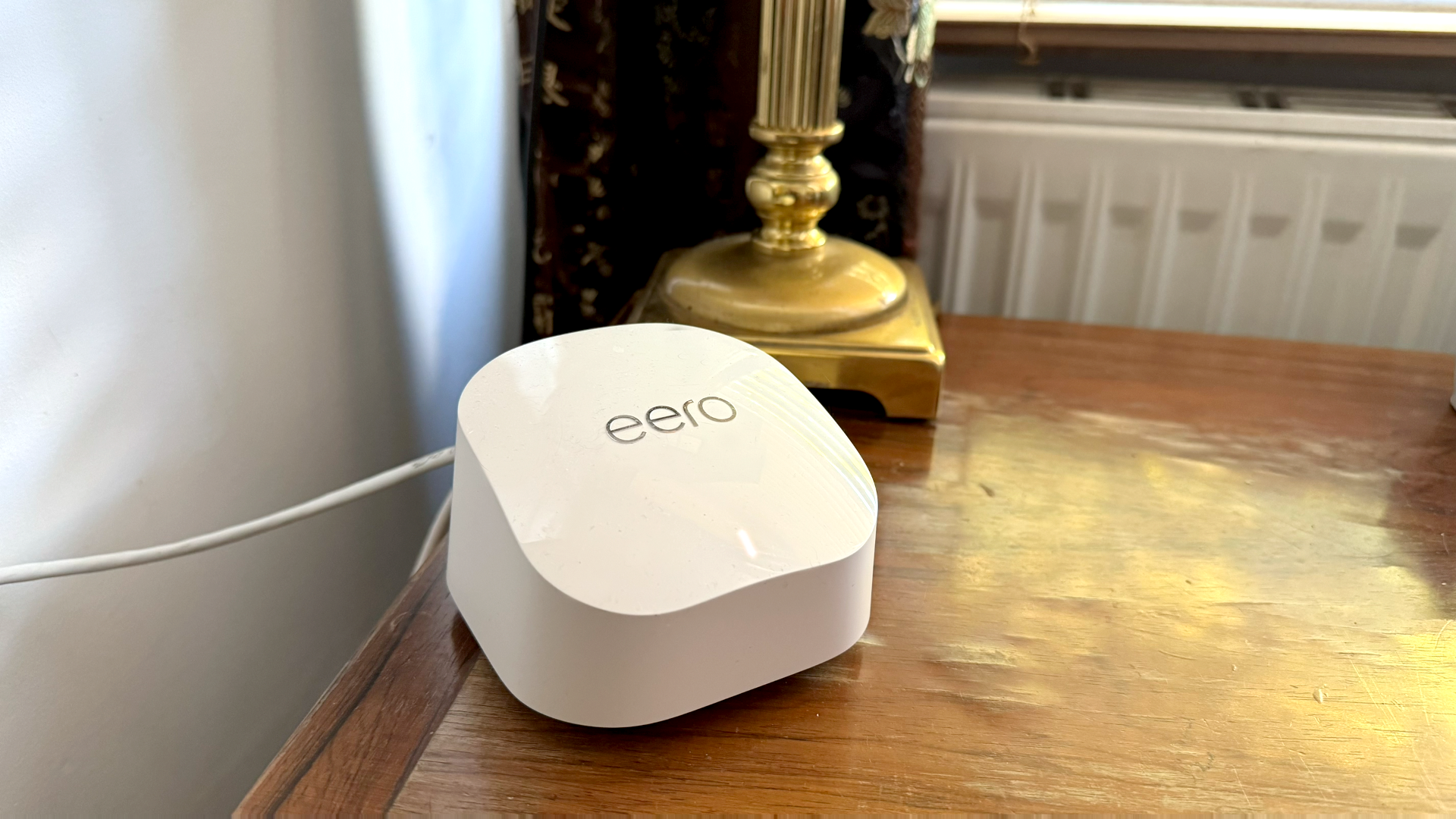
As far as getting my wifi signal sorted out, it worked brilliantly. And the Sonos system was still pumping out the Dolby Atmos without any apparent issue; so all seemed well.
But (here it comes…) then I noticed that the Sonos app wasn’t seeing my AV system at all. Which I found irritating. I want to know what signal is being fed out by the Arc, and I couldn’t see if it was coming through simply in 2.0 stereo, 5.1 surround or full-fat Dolby Atmos.
So (and I shudder as I type these words) I did a system reboot on the Arc and the surround speakers. Which was the start of about a month of hair-pulling frustration, blind alleys and a complete rethink.
I tried over and over again to find the Arc on the app; and time and time again, the process would start well enough, but then the app said that something had gone wrong and it couldn’t complete the Arc set-up. I did factory reset after factory reset, turned it all off and on again, burned a couple of sacrifices at the altar of the AV gods, and turned around three times anti-clockwise. Nothing worked.
The usual Google search told me that I should perhaps use a different smart device to link to the Arc. It so happened that I was in the process of changing my phone, so I thought I would wait for that to happen.
The Arc, while all this was going on, was still working as far as putting out the TV’s sound – but I had no idea what format it was outputting. And, because I had reset everything, it no longer linked to the two Symfonisk speakers that should have been the rear surrounds. They, of course – just to raise my ire even more – were talking to the Sonos app and linking to each other without even the murmur of a fuss; it was only the Arc that wouldn’t play ball.
I know: let's change broadband provider at the same time
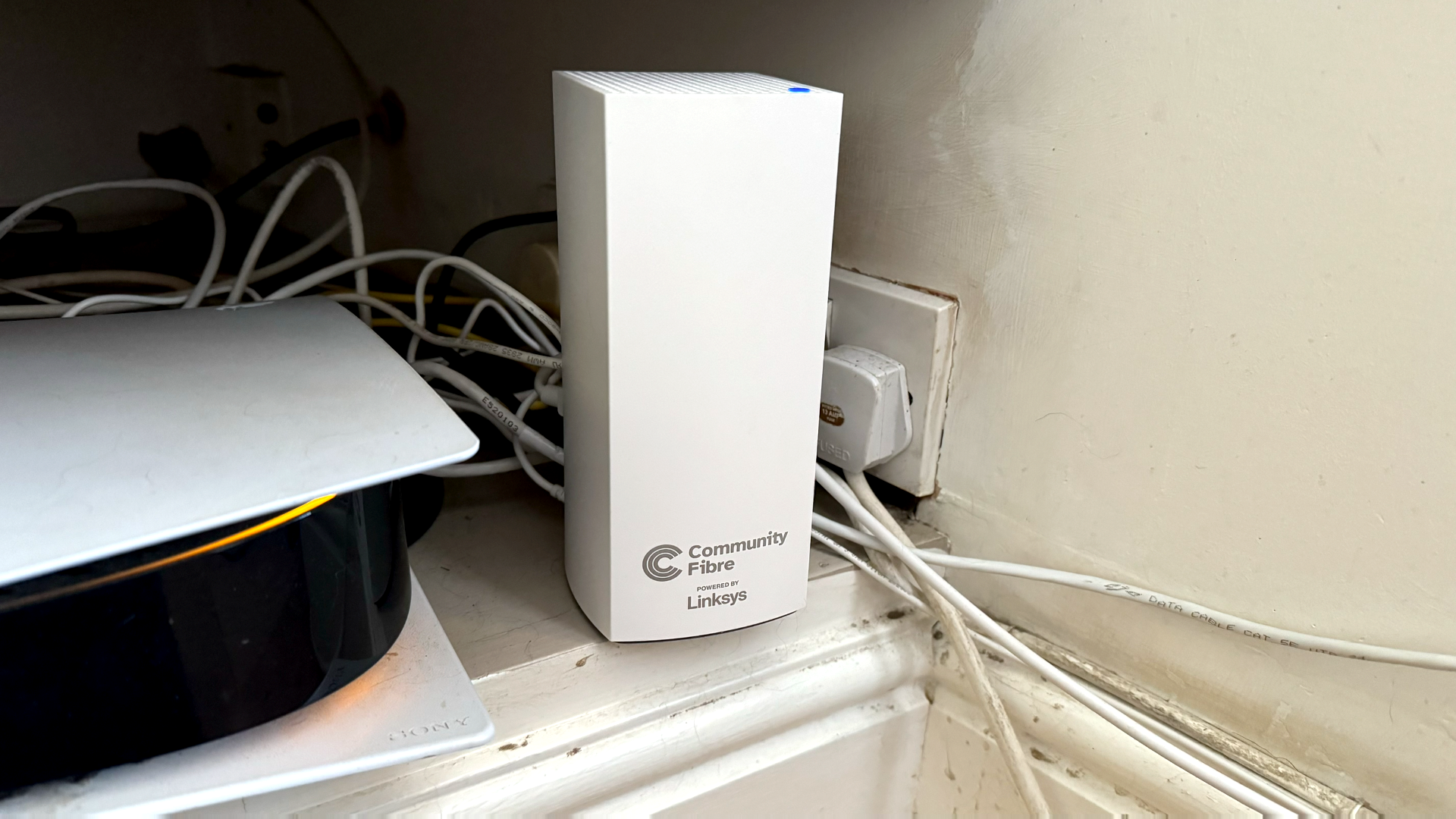
Then, just to give myself a proper challenge, I decided to change broadband provider, after an offer that would give me twice the speed for about two-thirds of the price; no brainer.
My new phone came at about the same time as the broadband was plumbed in. The Community Fibre chap who installed it was approving of the eero mesh set-up I had got only about a month previously, which was a relief. Once he had done his thing, I sorted everything out so that all the various routers and nodes were using the same network and password, crossed my fingers and set to with Sonos set-up on my new router(s) and iPhone.
With the same result. Every other Sonos product was findable and controllable without any issue – set-up was as simple as it ought to be from the excellent Sonos app. Except for, you guessed it, the Arc.
I confess I had a tiny sense-of-humour failure at this point, and, after about the fifth system reboot and factory reset of the day, was on the point of taking a nine-iron to anything vaguely electronic in the living room. I managed to resist the urge, though, and let things rest for a while.
I tried once again the next weekend, with the same non-result. And gave up.
But then, I wondered about the eero 6+ set up. And there, hidden away on the Google search was a potential issue with the Arc talking to the eero. Had I finally stumbled on the issue? Knowing my luck, probably not; but it was worth a go.
I decided to reset the Community Fibre set-up so that the Linksys router that it arrives with had a separate name and password to the eero 6+ set-up. Not as neat on the wi-fi, but hey, if it sorts out the home cinema issue, worth the hassle.
And, joy of joys, so it proved. A direct link to the Linksys router, and avoiding the eero 6+ altogether, met with the full approval of the Arc. I finally managed to get the app to recognise the soundbar, and the two Symfonisk rears; I was allowed a fully working surround system once again. The entirely unreasonable and rather inappropriate feeling of joy I got when it all started to work properly once again was somewhat shaming – I mean, talk about first-world problems. I felt it all the same. It is always at the darkest point that the light finally appears, it seems.
It's working! And there are some other improvements
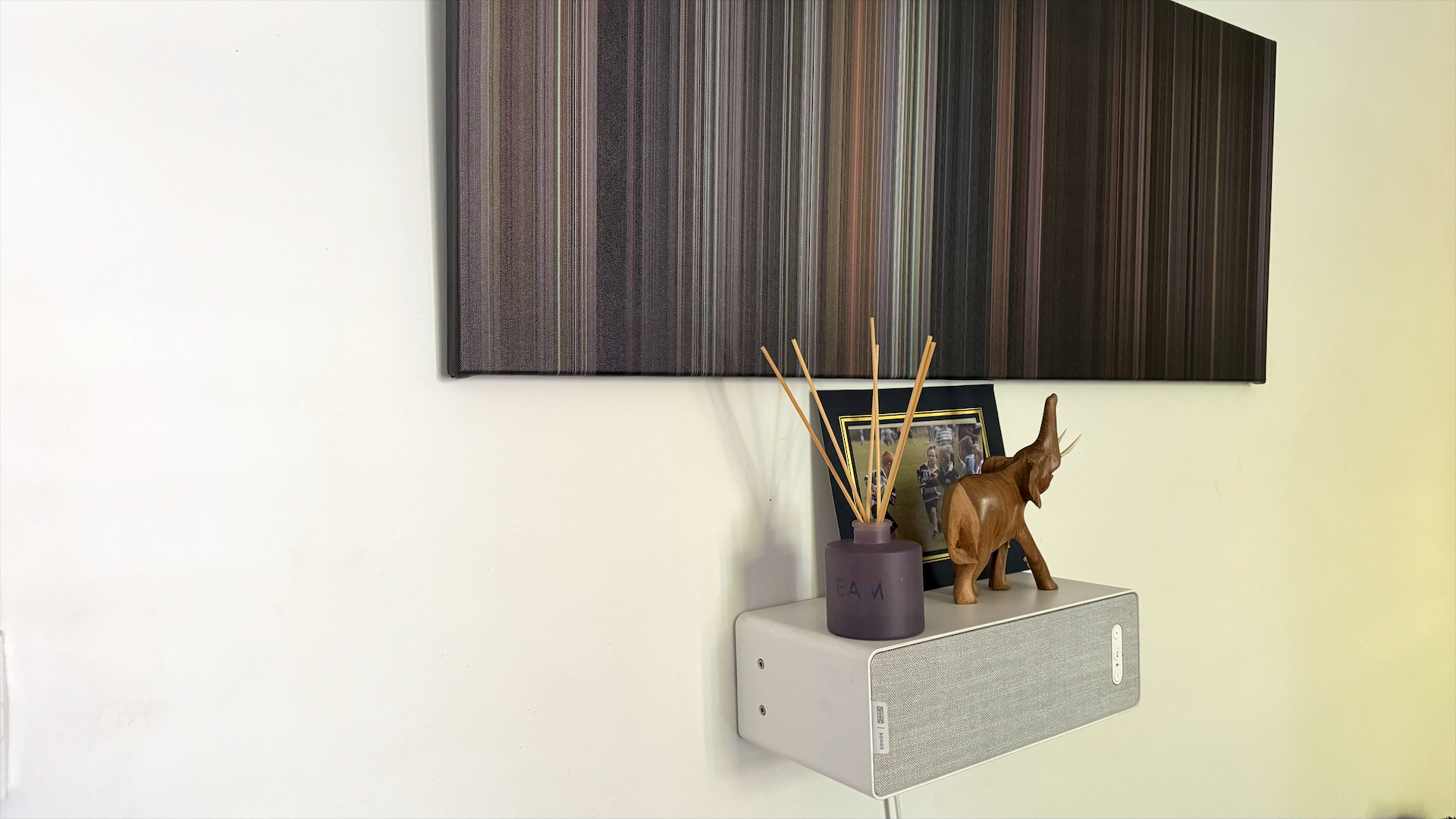
An update on another issue: the Sky Q and Arc lip synch issues remain, although in one important area it has been resolved. I have got used now to taking the 10 seconds or so to change the audio out settings on the Sky Q to and from multichannel out when necessary.
Now, though – happily – on a 4K broadcast with Dolby Atmos sound, the lip synch is perfect. You don't get many of these of course, but when it happens it works beautifully. For any other codec though, the synch issue remains an irritation, so back to the basic two-channel setting I go. Irritating, but not the end of the world once you simply accept the problem.
So, what’s next? Well, while I am perfectly happy with the surround sound that the Symfonisk pair provide – and I have compared them with two Sonos Ones, which didn’t really merit the change for convenience’s sake as much as anything – I am keen to see what difference having some Dolby Atmos-enabled speakers as surrounds might make. So I am planning to pinch the two Sonos Era 300s we have in our test rooms to compare the two set-ups. That, though, must be for next time.







